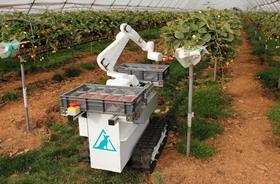
Robots are part of the solution to potential migrant labour shortages but a lack of investment is slowing progress, delegates at the NFU Conference in Birmingham were told this week.
Unfavourable exchange rates and societal animosity towards migrant workers following the Brexit vote have sparked concern among farmers over their ability to source enough seasonal and permanent staff from overseas.
Advances in agricultural robotics could soon begin to ease this uncertainty, however, by beginning to replace some of the semi-skilled migrant workers on British farms. For this to happen the industry must be prepared to invest in bringing technology to fruition, delegates were told.
Prof Simon Blackmore, a researcher in agricultural robots and smart machines at Harper Collins University, said: “With the types of technology that we’re developing it is actually the seasonal labour role that we can replace. Robots are good for semi-skilled highly repetitive tasks.”
However he stressed that introducing more robots to the industry is “disruptive” and “would need big changes”. The problem is not that the technology does not exist, he argued, but that there is not enough investment from the large machinery manufacturers to create the robots.
“I speak to [the big machinery manufacturers] quite regularly but they’re not interested in investing in technology that is going to disrupt their current business model,” the university researcher said.
“The only way of getting these machines into the farming community I believe is through start-up companies. I’m working with a number of young people who have a vision for developing robots in agriculture.”
Blackmore highlighted some of the areas of agri-technology that he is working on at Harper Adam’s Agri-Epi Centre. These include laser weeding, which uses cameras to identify weeds and destroys them with lasers and targeted herbicides; robotic strawberry harvesting; and driverless tractors.
Blackmore’s talk was followed by presentations from a panel of growers, who shared their experiences of how agri-tech has improved their businesses.
Essex farmer Tom Bradshaw, who grows peas and beans among other crops, talked about how he uses computerised mapping technology to optimise seed and fertiliser spreading and boost efficiency and yields. “I am able to put fertiliser in the right place at the right time,” he said, “and putting more seeds where there is a lower germination rate.
“It is hugely beneficial and has to make good sense although, economically, it is still difficult to say whether or not we are better off because we have adopted all this technology.”
Berry grower Harry Hall from the Hunter Hall Partnership, meanwhile, has switched from using halogen to LED lights in an effort to save energy and improve yields. He has also begun using artificial light instead of sunlight to allow him to continue growing in the dark months of November and January, as well as exploring the use of more robust tunnels (capable of withstanding 80mph winds), investment in reservoirs and “black box growing”.
When it comes to robotic harvesting in berries, the panel was keen emphasise that the technology is not there yet - however a project is ongoing at Cambridge-based start-up Dogtooth Technologies to develop robotic strawberry harvesters (see picture).It should not be seen as a solution to labour concerns in the short-term, but rather a longer-term development to watch out for.



